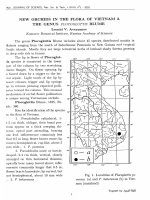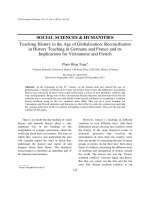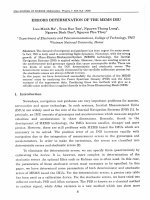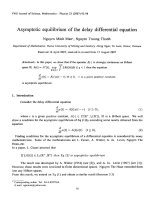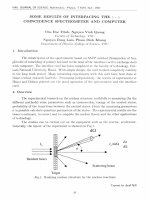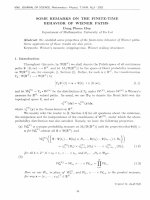DSpace at VNU: Volatile Constituents of the Leaf Oil of Alchornea tiliifolia (Benth.) Muell. (Family Euphorbiaceae) from Vietnam
Bạn đang xem bản rút gọn của tài liệu. Xem và tải ngay bản đầy đủ của tài liệu tại đây (174.29 KB, 3 trang )
This article was downloaded by: [Thammasat University Libraries]
On: 08 October 2014, At: 18:10
Publisher: Taylor & Francis
Informa Ltd Registered in England and Wales Registered Number: 1072954 Registered office: Mortimer
House, 37-41 Mortimer Street, London W1T 3JH, UK
Journal of Essential Oil Research
Publication details, including instructions for authors and subscription information:
/>
Volatile Constituents of the Leaf Oil of Alchornea
tiliifolia (Benth.) Muell. (Family Euphorbiaceae) from
Vietnam
a
b
b
Nguyên Anh Dũng , Trân Đình Thăng , Hoàng Văn Lų'u & Nguyên Xuân Dũng
a
Faculty of Biology , Vinh University , 182, Le Duan, Vinh, Vietnam
b
Faculty of Chemistry , Vinh University , 182, Le Duan, Vinh, Vietnam
c
c
Faculty of Chemistry , College of Natural Science, Hanoi National University , 19-Le
Thanh Tong, Hanoi, Vietnam
Published online: 09 Dec 2011.
To cite this article: Nguyên Anh Dũng , Trân Đình Thăng , Hoàng Văn Lų'u & Nguyên Xuân Dũng (2009) Volatile
Constituents of the Leaf Oil of Alchornea tiliifolia (Benth.) Muell. (Family Euphorbiaceae) from Vietnam, Journal of
Essential Oil Research, 21:1, 1-2, DOI: 10.1080/10412905.2009.9700091
To link to this article: />
PLEASE SCROLL DOWN FOR ARTICLE
Taylor & Francis makes every effort to ensure the accuracy of all the information (the “Content”) contained
in the publications on our platform. However, Taylor & Francis, our agents, and our licensors make no
representations or warranties whatsoever as to the accuracy, completeness, or suitability for any purpose of
the Content. Any opinions and views expressed in this publication are the opinions and views of the authors,
and are not the views of or endorsed by Taylor & Francis. The accuracy of the Content should not be relied
upon and should be independently verified with primary sources of information. Taylor and Francis shall
not be liable for any losses, actions, claims, proceedings, demands, costs, expenses, damages, and other
liabilities whatsoever or howsoever caused arising directly or indirectly in connection with, in relation to or
arising out of the use of the Content.
This article may be used for research, teaching, and private study purposes. Any substantial or systematic
reproduction, redistribution, reselling, loan, sub-licensing, systematic supply, or distribution in any
form to anyone is expressly forbidden. Terms & Conditions of access and use can be found at http://
www.tandfonline.com/page/terms-and-conditions
J. Essent. Oil Res., 21 (January/February 2009)
Volatile Constituents of the Leaf Oil of Alchornea
tiliifolia (Benth.) Muell. (Family Euphorbiaceae) from
Vietnam
˜ Anh Dung,
Nguyˆen
˜
Faculty of Biology, Vinh University, 182- Le Duan, Vinh, Vietnam
Tran
ˆ Ðình Thang
˘´
and Hoàng Van
˘ Lu’u,
·
Downloaded by [Thammasat University Libraries] at 18:10 08 October 2014
Faculty of Chemistry, Vinh University, 182- Le Duan, Vinh, Vietnam
˜ Xuân Dung,*
Nguyˆen
˜
Faculty of Chemistry, College of Natural Science, Hanoi National University, 19-Le Thanh Tong, Hanoi, Vietnam
Abstract
The leaf oil of Alchornea tiliifolia (Benth.) Muell. produced from plants growing in Pu Mat National Park,
Nghean province, Vietnam was prepared by steam distillation. The oil was analyzed by GC and GC/MS. A total of 45
compounds were identified, of which b-pinene (31.4%), linalool (17.0%) and b-caryophyllene (10.7%) were found
to be major components.
Key Word Index
Alchornea tiliifolia, Euphorbiaceae, essential oil composition, b-pinene, linalool, b-caryophyllene.
Introduction
Experimental
The Euphorbiaceae family consists of about 317 genera and
5000 species which are widespread, primarily in the tropics and
subtropics, poorly represented in temperate regions (1). About
70 genera and 460 species are distributed in Vietnam (2).
Many species of Euphorbiaceae are of economic importance, such as sources of medicine, provisions, paint, rubber,
insecticides, etc. (1,3).
Alchornea tiliifolia (Benth.) Muell. (Local name: Dom
dom la day) (syn. Stipellaria tiliifolia Benth.) is one of the 60
species belong to the genus Alchornea, distributed in Son La,
Cao Bang, Quang Ninh, Bac Can, Tuyen Quang, Phu Tho, Ha
Tay provinces, Vietnam (2); India, China, Laos, Cambodia,
Malaysia and Thailand (3).
In the course of the systematic study of Alchornea species
in Indochina, mono-, sesquiterpenes and other components
of the leaf oil of A. tiliifolia from Nghean province, Vietnam
have been investigated.
Source: Alchornea tiliifolia (Euphobiaceae) is a shrub tree
that can grow up to 1–3 m high in Vietnam. Leaves were collected in Pu Mat National Park, Nghean province. A voucher
specimen (DD4) has been deposited in the Herbarium of the
Institute of Ecology and Biological Resources, Vietnamese
Academy of Science and Technology.
Fresh leaves were shredded and their oil was obtained by
steam distillation for 3 h at normal pressure, according to the
Vietnamese Pharmacopoeia (4). The yield of the fresh leaf oil
was 0.22%.
GC: About 15 mg of oil, which was dried over anhydrous
sodium sulfate, was dissolved in 1 mL of CH3OH (for spectroscopy or for chromatography).
GC analysis was performed on a HP 6890 Plus Gas chromatograph equipped with a FID and fitted with a 25 m x 0.25
mm x 0.25 mm film thickness HP-5MS column. The analytical
conditions were: carrier gas H2 with flow rate 35 cm/min, injec-
Received: February 2005
*Address for correspondence
Revised: December 2006
1041-2905/09/0001-01$14.00/0—© 2009 Allured Business Media
Vol. 21, January/February 2009
Accepted: December 2006
Journal of Essential Oil Research/1
Dung
˜
et al.
tor temperature (PTV) 250°C, detector temperature 260°C,
temperature programmed 60°C (2 min hold) to 220°C (10
min hold) at 4°C/min. The relative percentage amounts of the
separated compounds were computed from FID data without
the use of correction factors.
GC/MS: A Hewlett Packard 6890 Plus Chromatograph
was fitted with the same fused silica HP-5MS capillary col-
lumn. The conditions of use were the same as described above
except that He was the carrier gas with flow rate 30 mL/min,
and there was an interface with a mass spectrometer HP 5972
MSD (70 eV). The temperature was programmed as reported
above. Component identification was carried out by comparing
MS data with those reported in Wiley Library on Chemstation
HP, and in some cases substances identified from oils known
composition and also with standard substances (5–10).
Results and Discussion
Table I. Percentage composition of the leaf oil
of Alchornea tiliifolia from Vietnam
Downloaded by [Thammasat University Libraries] at 18:10 08 October 2014
Compound
RI
a-thujene
931
a-pinene
939
camphene
953
sabinene
976
b-pinene
980
myrcene
990
a-terpinene
1019
p-cymene
1028
limonene
1032
1,8-cineole
1034
(Z)-b-ocimene
1042
(E)-b-ocimene
1053
g-terpinene
1061
terpinolene
1090
linalool
1100
nonanal
1104
a-fenchol
1112
borneol
1167
terpinen-4-ol
1179
a-terpineol
1191
myrtenol
1195
neryl formate
1267
a-copaene
1378
b-cubebene
1392
a-cedrene
1411
b-caryophyllene
1419
b-gurjunene
1434
a-humulene
1454
(E)-b-farnesene
1459
allo-aromadendrene
1460
g-curcumene
1480
germacrene D
1480
(Z,E)-a-farnesene
1484
a-muurolene
1500
(E,E)-a-farnesene
1509
bicyclogermacrene
1506
(Z)-g-bisabolene
1515
d-cadinene
1525
(E)-g-bisabolene
1533
a-calacorene
1542
nerolidol*
caryophyllene oxide
1581
bisabolol oxide B
1619
g-eudesmol
1630
farnesol*
% FID
0.4
8.4
0.2
1.5
31.4
0.9
0.3
0.4
1.2
0.5
trace
0.2
1.2
0.3
17.0
0.1
trace
trace
0.8
0.5
0.1
0.3
1.4
0.3
trace
10.7
0.5
1.5
1.1
0.2
0.5
0.7
0.3
0.1
2.3
4.3
0.4
0.3
0.1
0.2
trace
1.4
0.1
0.11
5.9
The leaf oil of A. tiliifolia from Vietnam, obtained in 0.22%
yield was composed entirely of mono- and sesquiterpenes.
Forty-five components were identified in the oil (Table I).
The main components were b-pinene (31.4%), linalool (17.0%)
and b-caryophyllene (10.7%). These compounds accounted for
59.1% of the oil. These main compounds and other oxygenated
components such as 1,8-cineole, nonanal, a-fenchol, borneol,
terpinen-4-ol, a-terpineol, myrtenol, neryl formate, nerolidol,
caryophyllene oxide, bisabolol oxide B, eudesmol and farnesol
contribute to the characteristic aroma of the leaf oil.
Other less predominant compounds were a-pinene (8.4%),
a-bisabolene (4.3%) and farnesol (5.9%).
To the best of our knowledge until now no publication on
chemical composition of the essential oil of this species has
been published.
Acknowledgments
The authors wish to thank Vu Xuan Phuong, Institute of Ecology and Biological Resources, Vietnamese Academy of Science and
Technology for confirmation of the plant identity and Pu Mat National
Park for help collecting samples.
References
1. Z.G. Wu and P.P.H. Raven (Eds.), Flora of China. Vol. 11 (Oxalidaceae
through Aceraceae). Science Press, Beijing, China and Missouri Botanical
Garden Press, St. Louis, MO (in preparation 2005).
2. N.T. Ban (Ed.), Checklist of Plant Species of Vietnam. Agricultural Publishing
House, Hanoi, Vietnam (2003).
3. R. Smith, Genera Euparbiacearum (Royal Botanic Gardens, Kew)
(2001).
4. Vietnamese Pharmacopoeia. Medical Publishing House, Hanoi, Vietnam
(1997).
5. S.R. Heller and G.W.A. Milne, EPA/NIH Mass Spectral Data Base. U.S.
Government Printing Office, Washington, DC (1978,1980,1983).
6. E. Stenhagen, S. Abrahamsson and F.W. McLafferty, Registry of Mass
Spectral Data. Wiley, New York, NY (1974).
7. A. Swigar and R.M. Siverstein, Monoterpenens. Aldrich, Milwaukee, WI
(1981)
8. R.P. Adams, Identification of Essential Oil Components by Gas
Chromatography/Quadrupole Mass Spectrometry. Allured Publ. Corp.,
Carol Stream, IL (2001).
9. D. Joulain and W.A. Koenig, The Atlas of Spectral Data of Sesquiterpene
Hydrocarbons. E.B. Verlag, Hamburg, Germany (1998).
10. N.X. Dung, P.H. Ngoc, D.D. Rang, N.T. Nhan, N.Klinkby and P.A. Leclercq,
Chemical Composition of the Volatile Concentrate from the Flowers of
Vietnamese Alstonia scholaris (L.) R., Br., Apocynaceae. J. Essent. Oil
Res., 13, 424–426 (2001).
trace < 0.1%; * correct isomer not identified.
2/Journal of Essential Oil Research
Vol. 21, January/February 2009


